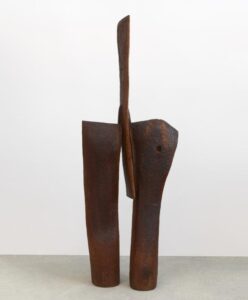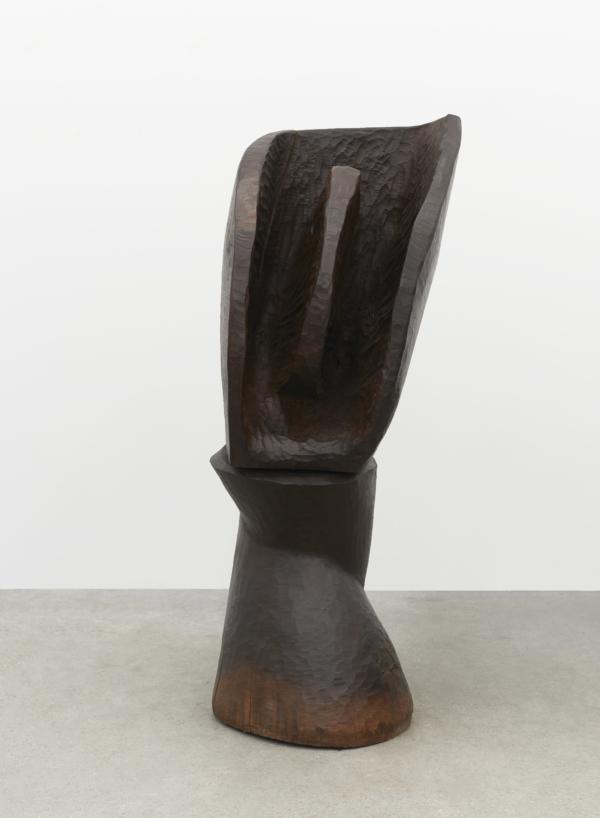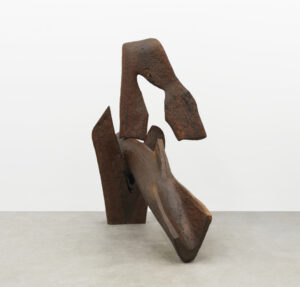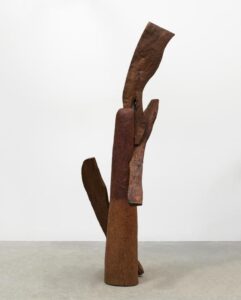
Thaddeus Mosley
Karma, New York until 29–July 24, 2020
Region in Suspension, 1996
About:
Karma is pleased to present a solo exhibition by Thaddeus Mosley. This will be Mosley’s first exhibition with the gallery.
Thaddeus Mosley’s monumental freestanding sculptures are crafted with the felled trees of Pittsburgh’s urban canopy, via the city’s Forestry Division; wood from local sawmills; and reclaimed building materials. With influences ranging from Isamu Noguchi to Constantin Brâncuși—and the Bamum, Dogon, Baoulé, Senufo, Dan, and Mossi works of his personal collection—Mosley’s sculptures mark an inflection point in the history of American abstraction.

Enclosure, 2006
Painter Sam Gilliam describes Mosley as “a jazz critic, post-man, father, keeper of trees anywhere– / old trees, round trees, big trees, heavy trees.” Using only a mallet and chisel, he coaxes salvaged timber into new, biomorphic shapes that conjure an uncanny forest. Mosley uses traditional joinery techniques to manipulate form, weight, and space, as evidenced by gravity-defying sculptures like Mirrored Space (2014) and Aero Intersectional (2018). The bold, sinuous curvature of these sculptures derive from existing recesses and protrusions in their raw material.
“My woods and stones and I generate themes together,” Mosley says. These “sculptural improvisations,” as he calls them, exercise a rhythmic abstraction, informed by the modernist tradition of jazz. Mosley carves with the spontaneity of a jazz composer: each fissure and groove in his hewed compositions represents an almost-audible warble. He frequently sculpts as an ekphrastic response to music. Such homages abound throughout the exhibition, including references to “Misterioso” and “Off Minor” by Thelonious Monk; Matisse’s jazz cut-outs; and tenor saxophonists Gene Ammons and Sonny Stitt, among others. “I never know exactly what I’m doing,” says Mosley. “That’s also the essence of good jazz.”
Since 1959 Thaddeus Mosley’s work has been exhibited and acquired by major museums, collections, and foundations, including the Mattress Factory Museum, Martin Luther King Jr. Library, and David L. Lawrence Convention Center, Pittsburgh; the Westmoreland Museum of American Art, Greensburg; and the Carnegie Museum of Art, Pittsburgh, for the occasion of the 57th Edition Carnegie International (2018). Recent solo exhibitions include CUE Art Foundation, New York (2014); Paul Mesaros Gallery, Morgantown, West Virginia (2011); August Wilson Center, Pittsburgh (2010); and the Mattress Factory Museum, Pittsburgh (2009).
Karma will publish a comprehensive monograph to accompany the exhibition, featuring essays by Jessica Bell Brown, Connie H. Choi, Brett Littman, and Ed Roberson; with a foreword by Ingrid Schaffner; a poem by Sam Gilliam; and an extensive interview by Hans Ulrich Obrist.


Inclination, 2003/Circled Planes, 2016
2.
Thaddeus Mosley (b. 1926) is a Pittsburgh-based self-taught artist whose monumental sculptures are crafted with the felled trees of Pittsburgh’s urban canopy, via the city’s Forestry Division; wood from local sawmills; and reclaimed building materials. Using only a mallet and chisel, he reworks salvaged timber into biomorphic forms. With influences ranging from Isamu Noguchi to Constantin Brâncuși—and the Bamum, Dogon, Baoulé, Senufo, Dan, and Mossi works of his personal collection—Mosley’s sculptures mark an inflection point in the history of American abstraction. These “sculptural improvisations,” as he calls them, take cues from the modernist traditions of jazz. “The only way you can really achieve something is if you’re not working so much from a pattern,” Mosley says of his improvisational method. “That’s also the essence of good jazz.” Mosley’s work has been exhibited and acquired by major museums and foundations since 1959, including the Mattress Factory Museum, Pittsburgh, and most recently, the Carnegie Museum of Art, for the occasion of the 57th Edition Carnegie International (2018).
